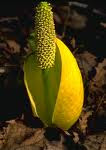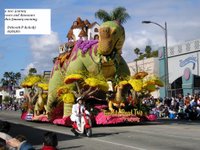:::::::::::::::::::::::::::::::::::::::::::::::::::::::::::::::::::::::::::::::::::::::::::::::::::::
American Skunk Cabbage, Lysichiton americanum
***** Location: Alaska
***** Season: Early Spring
***** Category: Plant
for banana (bashoo) see below
*****************************
Explanation
It's one of the first signs of spring here -- like giant yellow crocus.
And later, after the blossoms are gone, their enormous leaves just crowd into any landscape where they've ever, regardless of whether someone is trying to create a lawn there now.
Billie Wilson
http://home.gci.net/~alaskahaiku/saijiki.html
xxxxxxxxxxxxxxxxxxxxxxxxxxxx
American Skunk Cabbage, Lysichiton americanum

Skunk cabbage plants are easy to find in the West Hylebos Wetlands. The conditions are perfect for its growth, and it can be seen almost continuously as you stroll along the boardwalk.
A good time to observe them is in March and April, before nearby shrubs come into leaf. Skunk cabbage is one of our heralders of spring, because it’s yellow "lantern" emerges before most other "flowers" (see "Appearance" below for description of the actual flower). However, the blooms can continue until mid-summer, so skunk cabbage is a colorful addition to the wetland.
Appearance
Skunk cabbage has two features which make it very noticeable. One is the bright yellow spathe which mostly surrounds the spadix, which is covered by the actual flowers — small, yellow-green, and packed tightly on the club-like spadix. The other impressive feature is the very large leaves of this unusual plant. Possibly the largest leaves of any native plant, they can get 1.4 m (4 1/2') long, and 60 cm (2') wide. These features make skunk cabbage an unmistakable plant.
The skunk cabbage, also known casually as "swamp lantern," does smell mildly like a skunk, but is not offensive. It is when the leaves are crushed or decomposing that the odor more resembles the striped animal’s defensive spray.
Geographical Distribution and Habitat
The Western skunk cabbage is found from Alaska south to Northern California, and east (but less common) to Montana and Idaho. It is most common west of the Cascades, but is plentiful in wet areas inland.
This plant grows in swampy, boggy areas, and is generally found in the wet ground under or near cedar trees. It is sometimes a dominant understory plant of cedar/alder communities, especially in areas that support Western redcedar (Thuja plicata).
The Western skunk cabbage is the only member of the Arum family that is native to the Northwest.
http://www.hylebos.org/statepark/Skunk_Cabbage.htm
*****************************
Worldwide use
Flanders
Aronskelk (Aaronstab in German)
used for funeral wreaths... aronskelk de (m.) : arum
gevlekte aronskelk: wake-robin, friar's-cowl, lords-and-ladies
witte aronskelk: arum lily, calla lily.
on her coffin
a few arum lilies
and his kisses
Geert Verbeke
http://happyhaiku.blogspot.com/2004/01/friends-geert-verbeke.html
..................................................................................
Japan
Japanese Skunk Cabbage (Lysichiton camtschatcense)
is a Kigo for Mid-Summer.
Maybe the most famous place for Mizu Bashoo in Japan is the Swamp in Oze, Ozenuma 尾瀬沼. The flowers are usually of the white kind. Since the huge leaves resemble the leaves of a banana plant, it has the name of "Water Banana".
http://www.hana300.com/mizuba.html
Look at the Banana Leaves:
http://www.hana300.com/basyo0.html
This plant grows colder part of Japan, along the stream of snow-meltwater in spring. This plant is one of the most loved wildflowers in Japan. Japanese name Mizu-basyo(Water-banana) is from that leaf of this plant looks like the one of banana-plant. In spite of the prettyness of this flower, this plant have large leaf, hard to imagin from its flower.
http://www.asahi-net.or.jp/~vm5s-tjm/e/mizubasyou.htm
.................................................................
Yellow flowering Mizu Bashoo (Ki-Iro Mizu-Basho) 黄花水芭蕉
アメリカ・ミズバショウ(亜米利加水芭蕉) American Skunk Cabbage
http://aoki2.si.gunma-u.ac.jp/BotanicalGarden/HTMLs/america-mizubashou.html
*****************************
Things found on the way
Mizubasho Kokeshi dolls ミズバショウ こけし
from Oze

source : zenmaitarow/sab12
*****************************
HAIKU
overcast morning--
the rainforest brightens
with skunk cabbage
grassy June hillside--
grandson and friends sliding down
on skunk cabbage leaves
Billie Wilson (Modern Haiku XXX:2, 1999)
xxxxxxxxxxxxxxxxxxxxxxxxxxxxx
Skunk cabbage
and white tree lilies
full moon dream
--Michael Corr (Nagoya)
http://www.asahi.com/english/haiku/040927.html
*****************************
Related words
***** Banana plant - Musa paradisiaca
kigo for early summer
tama maku bashoo 玉巻く芭蕉 (たままくばしょう)
rolled leaves of the banana plant
..... bashoo no makiba 芭蕉の巻葉(ばほうのまきば)
tamatoku bashoo 玉解く芭蕉(たまとくばしょう)
unfolding of banana plant leaves
The leaves can be up to 2 meters long when they unfold.
During this time the banana plant is the most beautiful.

てらのにわ たままくばしょうに かぜしろし
temple garden -
rolled leaves of the banana tree
in white wind
Yuuka ゆうか
source : shashin-haiku.jp
kigo for mid-summer
aobashoo 青芭蕉 (あおばしょう) green bananan plant
..... bashoo wakaba 芭蕉若葉(ばしょうわかば)young banana plant leaves
natsu bashoo 夏芭蕉(なつばしょう)banana plant in summer
kigo for late summer
bashoo no hana 芭蕉の花 (ばしょうのはな) banana plant flowers
..... hana bashoo 花芭蕉(はなばしょう)
kigo for all summer
hime bashoo 姫芭蕉 (ひめばしょう) Calathea
"princess Basho"
..... bijinshoo 美人蕉(びじんしょう)
.................................................................................
kigo for all autumn
bashoo 芭蕉 (ばしょう) plantain, banana plant
Musa paradisiaca
..... niwakigusa 庭忌草
bashooba 芭蕉葉(ばしょうば)banana leaf / leaves
bashoorin 芭蕉林(ばしょうりん)banana grove
..... haseo はせを
. . . CLICK here for Photos !
This plant is best liked for its large leaves.
kigo for late autumn

yarebashoo 破芭蕉 (やればしょう) torn banana leaves
bashoo no yareha 芭蕉の破葉(ばしょうのやれは)banana leaves are torn
bashoo yabururu 芭蕉破るる(ばしょうやぶるる)
This often happens during the autumn typhoon season.
. Masaoka Shiki and his many torn banana leaf haiku .
正岡子規
.................................................................................
humanity kigo for all winter
karebashoo, kare bashoo 枯芭蕉 (かればしょう)
withered banana plant
bashoo karu 芭蕉枯る(ばしょうかる)banana plants are withering
.................................................................................
. bashoofu 芭蕉布(ばしょうふ) "banana fiber cloth"
humanity kigo for all summer
. banana バナナ banana fruit
plant kigo for all summer
:::::::::::::::::::::::::::::::::::::::::::::::::::::::::::::::::::::::::::::::::::::::::::::::::::::
芭蕉葉を柱に懸けん庵の月
bashooha o hashira ni kaken io no tsuki
one banana leaf
placed on the pillar -
the moon above my hut
Matsuo Basho, age 49
After he had come back from three years travelling, his friends had set him up again at Bashoan 芭蕉庵, the Banana Hut at Fukagawa, Edo.
His discipled had take off one leaf and written eight haiku on its backside. This was placed on one of the pillars.
From his hut, Basho enjoyed to watch the autumn moon.

芭蕉庵と芭蕉/江戸名所図鑑
In the accompanying text, Basho compares himself to two Chinese sages, who also enjoyed the banana plant leaves:
Zhang Hengqu (1020-1077) and Huaisu (725-785).
"The monk Huaisu ran his brush along it;
Zhang Hengshu gained strength for his studies just by gazing upon the emerging leaves."
- Reference -

source : www.metmuseum.org
Huai Su in the Banana Grove.
Gu Yun (1835–1896).
................................................................................
A frail hut with a leaking roof in a remote place, dwelling of a man of letters, was also a favorite of the Chinese hermits and Heian poets.
Basho phrased it this way:
芭蕉野分して盥に雨を聞夜哉
bashoo nowaki shite tarai ni ame o kiku yo kana
banana tree in a storm -
the dripping sound of rain in a tub
all night long
Tr. Gabi Greve
A banana plant in the autumn gale,
I listen to the dripping of rain,
Into a basin at night.
source : Janice Brown
風吹けばあだになり行くばせを葉の
あればと身をも頼むべき世か
kaze fukeba ada ni nariyuku bashooba no
areba to mi o mo tanomu beki yo ka
when the wind blows,
it proves transience -
the plantain leaves are torn;
is this the symbol of the world,
upon which men depend ?
Tr. Peipei Qui
. Priest Saigyo Hoshi 西行法師 .
My Thatched Roof is
Ruined by the Autumn wind
. . .
A great roof for the poorest gentlemen
of all this world,
a place to make them smile,
A building unshaken by wind or rain,
as solid as a mountain,
Oh, when shall I see before my eyes
a towering roof such as this?
Then I’d accept the ruin of my own little hut
and death by freezing.
Du Fu
- Reference -
. Chinese background of Japanese kigo .
:::::::::::::::::::::::::::::::::::::::::::::::::::::::::::::::::::::::::::::::::::::::::::::::::::::

Memorial stone at Nasu, Kurobane 那須町黒羽
鶴鳴くやその声に芭蕉破れぬべし
tsuru naku ya sono koe ni bashoo yarenu beshi
a crane is calling -
his voice will surely tear apart
the banana leaves
Tr. Gabi Greve
Written in the fourth lunar month 元禄2年4月
This poem had been written on a painting of a crane and banana plant, but the painting is lost now.
a crane screeches,
its voice ripping the leaves
of a banana plant
Tr. Ueda
There is a Chinese poem:
As the crane screeches in a deep valley
Its voice reached as high as heaven.
source : Ueda, google books
Oku no Hosomichi, Nasu, Kurobane
. Matsuo Basho 松尾芭蕉 - Archives of the WKD .
. Chinese background of Japanese kigo .
:::::::::::::::::::::::::::::::::::::::::::::::::::::::::::::::::::::::::::::::::::::::::::::::::::::
kigo for mid-summer
***** omodaka 沢瀉 (おもだか) water plantain, water arrowhead
..... hana kuwai 花慈姑(はなくわい)
namai 生藺(なまい)
yajikomo 野次菰(やじこも)
sentoosoo 剪刀草(せんとうそう)
Alisma plantago-aquatica. Sternfrucht
. arrowhead 慈姑 (くわい) kuwai .
kigo for early spring
:::::::::::::::::::::::::::::::::::::::::::::::::::::::::::::::::::::::::::::::::::::::::::::::::::::
[ . BACK to WORLDKIGO . TOP . ]
[ . BACK to DARUMA MUSEUM TOP . ]
:::::::::::::::::::::::::::::::::::::::::::::::::::::::::::::::::::::::::::::::::::::::::::::::::::::










































